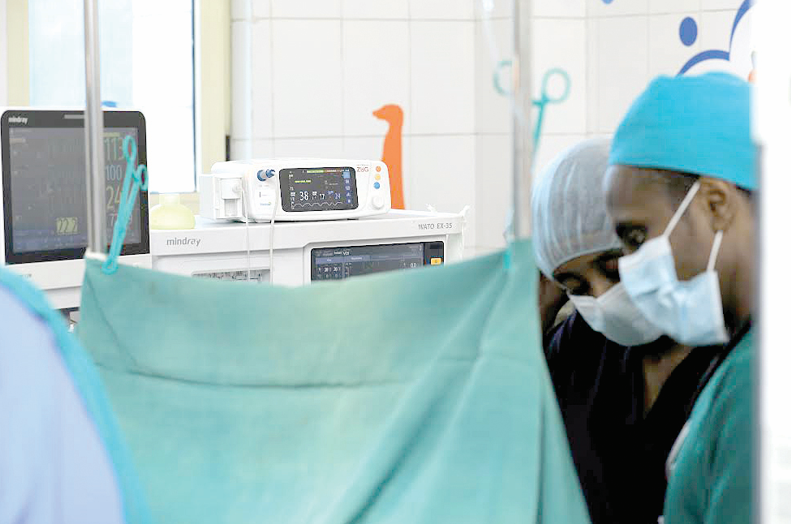Avail tool in theatres to curb deaths from anaesthesia

October 16th marked World Anaesthesia Day, which is celebrated each year to commemorate the first successful demonstration of diethylether anesthesia by William T G Morton. This groundbreaking discovery revolutionised medicine and made surgery possible for millions of people around the world.
Today, anesthesia is a safe and effective way to manage pain and discomfort during surgery and other medical procedures.
This year, the day was marked under the theme Anaesthesia and Cancer Care, which tries to raise awareness about the pivotal role of anaesthesia in cancer treatments. It also attempts to strengthen anaesthesia services to enhance the treatment for cancer.
Inadequate monitoring during anaesthesia can lead to catastrophic consequences, including brain damage and death. Children, in particular, are at a heightened risk of experiencing complications due to the misplacement of breathing tubes.
Monitoring tool
In light of a critical need for safe anaesthesia practices, especially in low-resource settings, Smile Train, the world’s largest cleft-focused organisation in partnership with Lifebox, a safer surgery non-profit organisation, have partnered to improve access to a high-quality medical device that is essential for safe surgery and currently only available in wealthy countries.
A capnograph is a vital monitoring tool for ensuring a patient receives adequate air supply during anaesthesia, and has been instrumental in reducing complications and deaths related to anaesthesia in high-income countries since its introduction in the 1990s.
It is the best tool to detect a leading cause of anaesthesia-related complications and deaths in low-resource settings: the misplacement of the breathing tube supplying oxygen to the patient. Without an oxygen supply, a patient will suffer catastrophic harm in a matter of minutes, including brain damage and death.
The risk of a misplaced breathing tube is greater in children hence increasing availability of capnography will significantly bridge the gap in anaesthesia safety for people-including children-undergoing surgery in low-resource settings.
Its introduction in the United States in 1991 led to a dramatic decline in anaesthesia-related complications and deaths. Yet, capnography remains largely unavailable across most low-resource setting operating rooms with research showing there is often a 100 per cent gap between the need for capnography and its availability in low-income countries.
“Putting a person under anaesthesia without a capnograph is like flying blind — you lack the basic information required to keep them safe,” says Dr Zipporah Gathuya, paediatric anaesthesiologist at Nairobi Hospital.
Bridging gap
“As healthcare providers, we are concerned that our surgical patients are not monitored with this essential device, even though it’s a standard practice in wealthy countries. Capnography shouldn’t be a privilege; it’s a demand for patient safety everywhere, and it’s needed now,” adds DrGathuya who is also a member of the Smile Train Global Medical Advisory Board.
According to medics, bridging the gap in anaesthesia safety through increased access to capnography will, therefore, have a profound impact on the well-being of paediatric patients undergoing surgery.
Dr Mary Nabukenya, a paediatric anaesthesiologist at Mulago Hospital and President Elect of Association of Anaesthesiologists of Uganda says for the longest time, there has been a monitor in at least every operating room in low and middle income countries that can tell anaesthesiologists how much oxygen is in a patient’s blood when they are having anaesthesia.
Dr Nabukenya explains: “As an anaesthesia provider, if I put a patient to sleep, I have to help them breathe by putting a breathing tube into their wind pipe. One of the things that can go wrong in this process is I could end up putting this tube into the patient’s oesephagus and what that means is that for a certain period of time, my patient is sleeping and their body is not getting enough oxygen.” “The monitor that we have-that tells us how much oxygen is in the blood-takes a few minutes before we can realise something is wrong. But this new device will tell me in the first breathe that the patient makes or the first assisted breathe that I give the patient that we are in the wrong place,” he adds.
With the device, within a few seconds, Nabukenya says she will know they are in the wrong place and quickly address the problem.
“That is why it is very important to monitor not just the patient’s oxygen, but also monitor the carbon dioxide that comes out of the patient when they are under anaesthesia,” she says.
As a paediatric anaesthesiologist who takes care of a lot of patients, she says her country’s population is nearly 50 per cent children and research has shown that 85 per cent of children are going to need surgery before they reach the age of 15 years.
“If you can think about what that volume of children is, it means there are many children who need surgery and if that surgery is not safe, then there are a lot of children that are being exposed to dangerous anaesthesia and surgery hence this highlights how important the capnograph device is,” says Dr Nabukenya.
The Smile Train-Lifebox Capnograph is affordable, user-friendly, and reliable, with sturdy construction and long battery life that meets rigorous specifications for monitoring paediatric patients and use in low-resource settings.
In addition, it combines capnography and pulse oximetry, making it doubly useful.
According to Dr Elizabeth Igaga, an anaesthesiologist and Director of Programmes Safety at Smile Train, the international standards have recommended that capnography is one of five standard monitors present in every operating room. Unfortunately, that is not the case, yet capnography helps in ensuring that surgery is performed in a safe manner and also helps the anaesthesia provider prevent potential risks and mitigate those risks before they happen.
Amend the guidelines for use
“Capnography has safeguarded surgical patients in the United States for over 30 years and yet, until now, this lifesaving monitoring tool has unfortunately remained inaccessible to most operating rooms in Africa,” says Dr Igaga.
“The availability of the affordable Smile Train-Lifebox Capnograph is the first significant step to bridge this gap. We hope the World Health Organisation (WHO) takes urgent steps to amend the guidelines for capnography use in safe anaesthesia, enabling its rapid adoption by low- and middle-income countries. Let’s close this gap and ensure that every surgical patient, regardless of their location, receives the care they deserve,” adds Igaga.
This year, 350 low-resource operating rooms will be equipped with the new Smile Train-Lifebox Capnograph —alongside training in its use for anaesthesia staff— including in Benin, Ethiopia, Philippines, and Uganda. This is to strengthen the safety of paediatric anaesthesia and surgical care in low-and middle-income countries.
“The launch of the Smile Train-Lifebox Capnograph will have a transformative impact on the safety of every child with cleft undergoing surgery hence strengthening surgical safety for all surgical patients as a result,” says Susannah Schaefer, Smile Train President and CEO.











